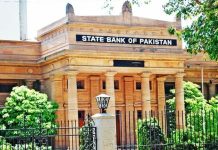ISLAMABAD: The Ministry of Finance says the government has achieved considerable success towards fiscal consolidation by supporting aggressive control on expenses and ensuring growth in tax and non-tax revenues, WealthPK reported on Friday.
It says the government’s debt is on a firm downward trajectory, where debt-to-gross domestic product (GDP) ratio has decreased by 4% during the last fiscal year (FY21) and hence the government expects that this ratio will decrease further by 2-3% during the ongoing fiscal year.
According to information obtained by WealthPK from official sources of the ministry, the government is taking necessary steps to ensure fiscal discipline and consolidation, stabilize the economy and accelerate growth.
The government has started revamping through structural reforms and stabilization measures such as broadening the tax base, reforming the public sector enterprises and reducing the fiscal deficit while ensuring that social safety net and development spending are not only protected but enhanced considerably.
All these measures are expected to bring stability and gradual reduction in fiscal deficit over next few years and subsequently would reduce the country’s reliance on additional debt. Most of the major adjustments to fiscal and monetary policies have already been made.
A better way to measure level of debt is through debt-to-GDP ratio. In this regard, international comparison also shows that Pakistan has performed much better in terms of managing its debt burden during the pandemic as debt-to-GDP ratio is projected to increase by 18 percentage points for advanced economies, 10 percentage points for emerging markets and 6 percentage points for low-income developing countries from their pre-pandemic levels, while Pakistan’s debt-to-GDP ratio witnessed an overall decline of 2.8 percentage points from its pre-pandemic levels. Over the medium-term, the government’s objective is to ensure gradual reduction in fiscal deficit which would subsequently reduce the country’s reliance on additional debt.
Public debt has two main components, namely domestic debt which is incurred principally to finance fiscal deficit, while the external debt is raised primarily to finance development expenditure. Domestic debt mainly includes government securities and national savings schemes.
External loans are mainly obtained from multilateral, bilateral sources, Eurobonds, commercial banks and the International Monetary Fund (IMF).
According to latest data showed by the State Bank of Pakistan (SBP), the central government’s domestic debt increased to Rs27.411 trillion by Jan 2022 as against Rs24.511 trillion during the same period of last year. The central government’s external debt increased to Rs14.982 trillion by Jan 2022 compared to Rs12.034 trillion during the same period of last year.
Hence, the central government’s total debt reached Rs42.394 trillion compared to Rs36.545 trillion during the same period of last year.
Similarly, the government’s domestic debt and liabilities increased to Rs27.986 trillion till Jan 22 compared to Rs25.018 trillion during the same period of last year.
Pakistan’s total debt and liabilities increased to Rs51.724 trillion till Dec 2021 (second quarter of the on-going fiscal year) as against Rs45.2 trillion during the same period of the last year. However, according to the estimates of the ministry, the total public debt increased by Rs16.5 trillion during July 2018 to Sept 2021.
The Finance Ministry highlighted that the major reasons for increase in total public debt included the financing of federal government’s primary deficit, interest on debt, exchange rate devaluation effect and cash buffer. In financing of primary deficit, the impact of economic slowdown due to the Covid-19 pandemic mainly resulted in higher than estimated primary deficits. Rs3.6 trillion (22% of increase) was borrowed for financing of primary deficit.
INP






